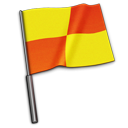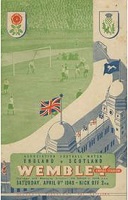239 vs.
Scotland
previous match (128 days)
244 vs. Switzerland
 245 245
253 vs.
Scotland |
 |
Saturday,
9 April 1949
Home International Championship 1948-49
(54th)
Match
England 1
Scotland 3
[0-1]
|
|
 |
Empire Stadium,
Empire Way, Wembley
Park, Wembley, Middlesex
Kick-off (BST):
3.00pm.
Attendance:
"99,500" (new Stadium
record).
Receipts:
"£39,100;"
"Non-paying spectators
brought the gate to over 100,000" |
1947.JPG)
|
 |
England kicked-off |
 |
|
[0-1]
Jimmy Mason 28
"Clever inter-passing [between] Steel and Reilly resulted in a centre
by Lawrie Reilly which Mason sidefooted into the net via the
post."
from seven yards with his right foot |
11.0 Film
2.45-4.40 England v Scotland
8.30 At the Villa Rose (play) |
.jpg) |
 |
|
[1-3]
Jackie Milburn 73
"Finney swept
past Young and made a short backpass. Mortensen tried a shot which was
going wide when Milburn ran in scored from close range." |
[0-2] Billy Steel 51
"Steel made a brilliant solo burst,
passed to Billy Houliston, received the ball back and made no
mistake with an open goal."
[0-3] Lawrie Reilly
header
61
"Billy Waddell made
[another] dash down the right wing, easily evaded Howe, and put across
a perfect centre. Reilly, coming up full-tilt, hurled himself at the
ball and a downward header entered the net." |
Commentators:
Jimmy Jewell and Peter Lloyd
also live on the Radio Light Programme -
commentator: Raymond Glendenning
and Sandy Munro |
|
|
|
flg.jpg)  "BOUNCING
SCOTS RAIDERS JUST RIDDLED OLD ENGLAND"
The People "BOUNCING
SCOTS RAIDERS JUST RIDDLED OLD ENGLAND"
The People |
  Officials Officials |
England |
UK ruling on substitutes |
Scotland |
Referee
Benjamin Mervyn Griffiths
40 (17 January 1909), Abertillery,
Monmouthshire. |
"Comparison by the number of bye-kicks shows how the game went. Swift had to
take 18; Cowan 8. Both sides had 7 corners. England had 9 free kicks against
our 5; 36 throw-ins as opposed to our 24. There were only two offside
decisions—one against each team." - The Sunday Post, 10
April 1949
Teams presented to
HRH Prince Philip. Also in attendance was Prime Minister Clement Attlee and
the Princess Elizabeth. |
|
Linesmen |
|
F. Owen |
F. Roberts |
|
|
|
flg.jpg) England
Team England
Team |
| |
|
Rank |
No official ranking system established;
ELO rating 3rd |
Colours |
The 1949 home
uniform -
White collared jerseys, blue shorts, red socks. - with
the new FA crest
|
|
P first of 43, W 0 - D 0 - L 1 - F 1 - A 3. |
Captain |
Billy Wright |
Manager |
Walter Winterbottom, 36 (31 March 1913), appointed as FA national director of coaching/team manager on 8 July 1946; |
|
4th
of 90, W 3 - D 0 - L 1 - F 14 - A 5. |
Trainer: Jimmy Trotter (Charlton Athletic FC) |
P 19th
of 139, W 14 - D 3 - L 2 - F 67 - A 17. |
|
|
Team chosen by Selection Committee headed by Arthur Drewry on
Wednesday, 30 March. |
flg.jpg) England
Lineup England
Lineup |
|
|
five changes
to the previous match
(Ditchburn, Ramsey, Rowley, Haines & Hancocks out) |
league position
(30 March) |
|
|
|
Swift, Frank V. |
35
104 days |
26 December 1913 |
G |
Manchester City FC (FL 7th) |
18 |
17ᵍᵃ |
|
2 |
Aston, John |
27
128 days |
3 September 1921 |
RB |
Manchester United FC
(FL 5th) |
4 |
0 |
|
3 |
Howe, John R. |
33
184 days |
7 October 1915 |
LB |
Derby County FC
(FL 3rd) |
3 |
0 |
|
final app
1948-49 |
|
4 |
Wright, William A. |
25
62 days |
6 February 1924 |
RHB |
Wolverhampton
Wanderers FC (FL 9th) |
19 |
0 |
|
5 |
Franklin,
Cornelius |
27
75 days |
24 January 1922 |
CHB |
Stoke
City FC (FL 8th) |
19 |
0 |
|
6 |
Cockburn,
Henry |
27
207 days |
14 September 1921 |
LHB |
Manchester
United FC (FL 5th) |
9 |
0 |
|
7 |
Matthews, Stanley |
34
67 days |
1 February 1915 |
OR |
Blackpool FC
(FL 13th) |
30 |
9 |
|
the third & oldest player to reach the
30 app
milestone |
|
8 |
Mortensen, Stanley H. |
27
318 days |
26 May 1921 |
IR |
Blackpool FC
(FL 13th) |
10 |
14 |
9
 |
Milburn, John E.T. |
24
333 days |
11 May 1924 |
CF |
Newcastle United FC
(FL 2nd) |
4 |
3 |
|
10 |
Pearson, Stanley C. |
30
88 days |
11 January 1919 |
IL |
Manchester
United FC (FL 5th) |
3 |
1 |
|
11 |
Finney,
Thomas |
27
4 days |
5 April 1922 |
OL |
Preston
North End FC (FL 22nd
(bottom)) |
15 |
12 |
|
reserves: |
Leon Leuty (Derby County FC (FL 3rd)),
Roy Bentley (Chelsea FC (FL 16th)). |
|
team notes: |
England wear the new crest for the first time.
'In a possible attempt to distinguish the badge from that
used by the England cricket team, a new emblem was designed by the
College of Arms. The lions were re-drawn with red claws and more
features, and the crowns were removed. Ten Tudor Roses were scattered around the
lions probably to represent the ten regional
divisions, each of which has a seat on the Football Association
Council.' |
|
records: |
This is England's first post-war home defeat.
This defeat
ends England's post-war unbeaten record of eleven matches without
loss. |
|
|
|
2-3-5 |
Swift -
Aston, Howe -
Wright, Franklin, Cockburn -
Matthews,
Mortensen, Milburn, Pearson, Finney. |
|
Averages: |
Age |
29 years 54
days |
Appearances/Goals |
12.2 |
3.4 |
|
England teams
v. Scotland: |
|
1948: |
Swift |
Scott |
Hardwick |
Wright |
Franklin |
Cockburn |
Matthews |
Mortensen |
Lawton |
Pearson |
Finney |
|
1949: |
Aston |
Howe |
Milburn |
|
|
|
 Scotland
Team Scotland
Team |
| |
|
Rank |
No official ranking system established;
ELO rating 13th to 10th |
Colours |
Blue jerseys
with white collars, white shorts, blue socks with red
tops. |
|
Captain |
George Young |
Selection |
The Scottish Football Association Selection Committee
on Wednesday, 30 March 1949. |
|
Trainer: Alex Dowdells (The Celtic FC) |
 Scotland
Lineup Scotland
Lineup |
|
|
Cowan, James C. |
22
297 days |
16 June 1926 |
G |
Greenock Morton FC |
5 |
7ᵍᵃ |
|
2 |
Young, George L. |
26
163 days |
27 October 1922 |
RB |
Rangers FC |
12 |
0 |
|
661 |
3 |
Cox, Samuel R. |
24
361 days |
13 April 1924 |
LB |
Rangers FC |
1 |
0 |
|
4 |
Evans, Robert |
21
267 days |
16 July 1927 |
RHB |
The Celtic FC |
3 |
0 |
|
5 |
Woodburn, William A. |
29
244 days |
8 August 1919 |
CHB |
Rangers FC |
6 |
0 |
|
662 |
6 |
Aitken, George G.M. |
23
316 days |
28 May 1925 |
LHB |
East Fife FC |
1 |
0 |
7
 |
Waddell, William |
28
33 days |
7 March 1921 |
OR |
Rangers FC |
4 |
3 |
8
 |
Mason, James |
29
3295 days |
18 June 1919 |
IR |
Third Lanark FC |
3 |
2 |
9
 |
Houliston, William |
28
5 days |
4 April 1921 |
CF |
Queen of the South FC |
2 |
2 |
10
 |
Steel, William |
25
343 days |
1 May 1923 |
IL |
Derby County FC, England |
10 |
4 |
11
  |
Reilly, Lawrance |
20
163 days |
28 October 1928 |
OL |
Hibernian FC |
2 |
1 |
|
reserves: |
Travelling reserves are Telfer (St. Mirren FC) and Thornton (Rangers FC).
Full team of reserves are Brown (Rangers FC);
Govan (Hibernian FC) and Young (Rangers FC); Telfer and Ian McColl
(Rangers FC); Jimmy Delaney (Manchester United FC) and Orr (Greenock
Morton FC); Thornton; Billy Liddell (Liverpool
FC); |
|
|
|
2-3-5 |
Cowan -
Young, Cox -
Evans, Woodburn, Aitken -
Waddell, Mason, Houliston, Steel, Reilly |
|
Averages: |
Age |
25 years 155
days |
Appearances/Goals |
4.5 |
0.8 |
|
youngest opposing post war team
so far |
|
|
|
|
Match Report by
Mike Payne |
|
 England
lost their first Home International since the war in a game watched by
nearly 100,000 people. Princess Elizabeth and the Duke of Edinburgh joined
the spectators under blue skies and a warm April sun. England
lost their first Home International since the war in a game watched by
nearly 100,000 people. Princess Elizabeth and the Duke of Edinburgh joined
the spectators under blue skies and a warm April sun.
For the first 25 minutes England tore into the Scottish defence with some
brilliant football. Unfortunately, they found Cowan in unbeatable form and
the goalkeeper virtually too England on single-handedly in this spell. Two
saves from Stan Mortensen will live long in the memory as he continually
kept Scotland in the match.
At the end of that period of England pressure, Cowan blocked Stan
Pearson's shot after Tom Finney had centred. Mortensen followed up to
flash the rebound towards the empty net, only to see Cox come from nowhere
to clear from the goal-line. Twice Jackie Milburn went close and Cowan
then saved brilliantly again, this time from Mortensen.
That final
save brought England's superiority to an end and the Scots then hit back
hard. On 29 minutes they took the lead. A throw-in by Houliston found
Steel, who gave Reilly a clever pass which took John Aston out of the
game. Reilly's cross was met by Mason and it was 1-0 as the ball went in
off the far post.
After the interval Scotland inspired by the goal,
were a changed side. Now moving quickly and effectively they were winning
all of the loose balls and most of the tackles. Only Neil Franklin stood
firm for England as Steel and Mason took control of the game.
In
the first 15 minutes of the second-half, Scotland scored two more goals to
virtually settle the result. Swift inter-passing between Mason and Steel
found Houliston. The centre-forward back-heeled out of a ruck of English
defenders and Steel was left with the easy task of walking the ball into
the net. When Reilly headed home Waddell's perfect cross a few minutes
later, the England defence was again caught flat-footed.
The home
side, devastated by these two goals, manfully tried to fight back and in
the last quarter of an hour came close to sensationally saving the game.
Milburn pulled one goal back when he diverted a Mortensen shot and then
Stanley Matthews saw a goalbound shot blocked by Milburn. Finally, in a
rousing finish, a Pearson header hit the bar.
Over all, Scotland
had deserved their win, but had it not been for the superb early work of
Cowan, then it might have been a different story.
|
|
Match Report by
Norman Giller |
|
The
selectors decided to make five changes in the team that beat Switzerland
6-0. With Derby County dynamo Billy Steel at his most potent, Scotland
tore into England after Scottish goalkeeper Jimmy Cowan had almost played
England on his own in the opening twenty minutes. Jimmy Mason, Steel and
Lawrie Reilly put the Scots on the way to the Home Championship before
Milburn snatched a consolation goal. Scotland's goalkeeper Jimmy Cowan was
rightly hailed as the hero because of a string of wonderful saves in the
first twenty minutes, but the real match winner for the Scots was their
left-back Sammy Cox. He usually played as a wing-half and everybody
expected Stanley Matthews to give him a roasting. But Sammy cleverly cut
Stanley out of the game by intercepting many of the passes meant for the
Maestro.
|
|
Match Report by
Glen Isherwood |
|
Both England, the reigning British Champions, and Scotland had won both
their previous matches. For England a point would give them their fifth
successive peacetime Championship. Scotland had not beaten England since
1938 and had not won the Championship outright since 1936.
For the first 25 minutes it was all England, but the Scotland
goalkeeper Jimmy Cowan made save after save to keep them out. Then
Scotland struck. Reilly crossed and Jimmy Mason flicked the ball just wide
of Swift to give the Scots a surprise lead. With an hour's play gone
Scotland were, incredibly, three goals up. First. Billy Steel put
Houliston through. Swift was slow in coming off his line but Aston managed
to stab the ball away from the attacker before he could shoot only for
Steel to net the attempted clearance. Then a Waddell cross was headed in
by Lawrie Reilly. England finally got a goal back in the last 15 minutes
when Finney laid the ball back for Mortensen whose shot was turned in by
Jackie Milburn.
England regained the Championship the following
year and qualified for their first World Cup in the process. Scotland
finished runners-up after losing 1-0 to England at Hampden Park.
|
|
Match Report
as appears in the F.A. Yearbook 1949-50, page 24 |
|
On April 9th 1949 came the last of the home Internationals of the season,
England v. Scotland, at Wembley, the match which was to decide the
International Championship. Both sides played first-class football, but it
was the Scottish superiority in finishing which enabled them to score
three goals to England's one, thus inflicting on England their first
defeat in the Championship since the war.
The match was divided into
two distinct phases. In the first England were consistently on the
offensive, foiled only by a series of brilliant saves by Cowan.
Then
Scotland passed to the offensive. Their first goal came in the 29th
minute, when a quick series of passes from Steel to Reilly and from Reilly
to Mason enabled Mason to tap the ball into the English net.
England's
defence was now shaken, and five minutes after the interval Scotland went
further ahead with another goal from Steel. Within a few minutes, Waddell
again beat Howe, and presented Reilly with a perfect centre to head into
goal.
In the last quarter of an hour, England fought back heroically.
Milburn, diverting a shot from Mortensen, gave England their only goal of
the match. But England's last minute effort raised no more than a forlorn
hope. Scotland had already made sure of the Championship.
|
In
Other News....
|
It was on 8 April 1949 that a three-year-old girl, Kathy Fiscus
fell into an abandoned well in California, and despite a massive
rescue effort involving three giant cranes, power drills, and
fifty floodlights rushed from Hollywood, the little girl died from
a lack of oxygen. A local television crew arrived and was the
first to provide live coverage of a rescue attempt such as this.
It took two days for them to reach the body, by which time 12,000
people had turned up to watch the tragic event. |
|
|
|
|
Source Notes |
TheFA.com
Original newspaper reports
London Hearts.com
Glen Isherwood's Wembley: The Complete Record |
|
Rothman's Yearbooks
Mike Payne's England: The Complete Post-War Record
Norman Giller, Football Author
British Pathé |
|
|
cg |
1947.JPG)
